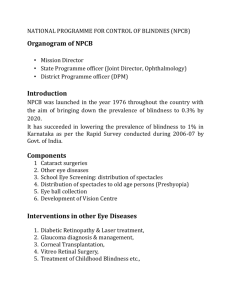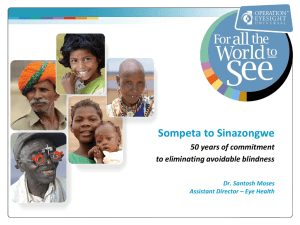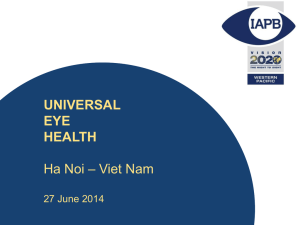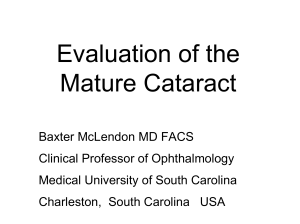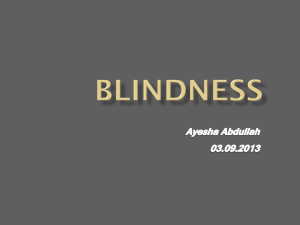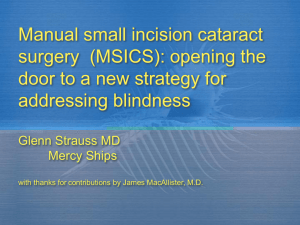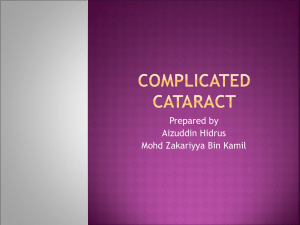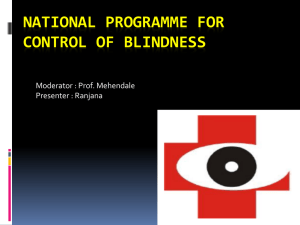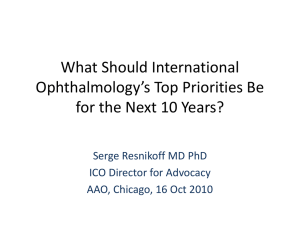Dr Paul Courtright_Introduction
advertisement
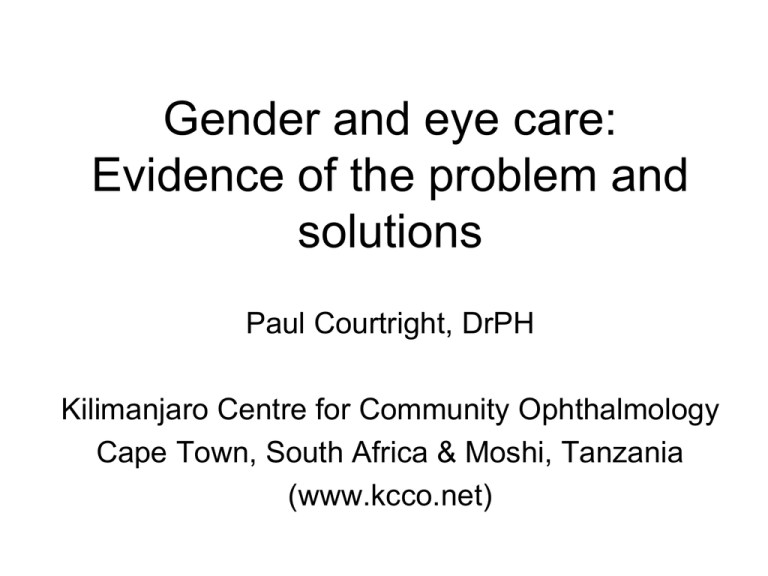
Gender and eye care: Evidence of the problem and solutions Paul Courtright, DrPH Kilimanjaro Centre for Community Ophthalmology Cape Town, South Africa & Moshi, Tanzania (www.kcco.net) Why are we here? What do we hope to accomplish today? Why are we here? Women account for 2 out of 3 blind people…. …if we are to achieve VISION 2020 we must address eye care needs of women A bit of history….Understanding the problem & generating the evidence for action 1. Systematic review of literature & meta-analysis 2. Analysis of potential reasons for differences in blindness figures 3. Disease specific assessments (including measuring service utilization) 4. Implementing strategies to address the issues Findings from meta-analysis of 70 population based surveys (published between 1980-2000) Age-adjusted odds of blindness in women compared to men – Africa: – Asia: – Industrialised: 1.39 (1.2-1.6) 1.41 (1.3-1.6) 1.63 (1.3-2.1) – Overall: 1.43 (1.3-1.5) Abou-Gareeb et al. Ophthal Epidem. 2001;8:39-56. What about the last 12 years? • Large national surveys (Ethiopia, Pakistan, Bangladesh & Nigeria) • Rapid Assessment of Avoidable Blindness (RAAB) surveys (about 28 in Africa) • Indian (state) RAAB surveys • Latin American RAAB surveys Analysis of potential reasons for gender disparity • Longer life expectancy in women – Women live longer and blindness is associated with increasing age. – However, age-specific rates of blindness show female excess in most age groups • Different risk for acquiring eye diseases – Slightly higher incidence of cataract among women – Higher incidence of trachomatous trichiasis among women • Unequal utilisation of eye care services – Cataract, trachoma, congenital/ developmental cataract Cataract Cataract Surgical Coverage (2002-8) Males Females 100% 80% 60% 40% 20% 0% a l) a n h ** ia bar u) zai) y a d s a n t a d n i k an Ke z i akw ar de nis d za a n a n w n r k I gl me R Za (Ch (S h Ta (O n t k u n an tan Ba ur o t a S T is kis st k i k Pa Pa Pa ** CSC calculated at 6/60 Lewallen et al, BJO 2009;93:295-8 ) ) a a e l s n a ti ro iqu m n g t e e te n g N a ( (A u Ar s G s ne ine i p p li ip ilip Ph Ph Ke Su ny da n Ke a (N (N ny ak ) Su a u r da (Kw u) n al Su (W e) da Nil n e) (S e U ga Tz n) nd (K a ili) (N M tu ad g E ag ri ) Su as tre da ( A a n t Su (N sin) da Kh n or (K ) TZ as (Z s) K e Ma a n ny li ( z) a Ko ( R S N ul) w an ya da n) (W R SA M ) (E alaw Bu Ca i ru pe) nd i( N ) CSC (by person) for men & women at <3/60 (ranked by highest to lowest overall CSC) 35 30 25 Higher in 20 men 15 10 5 0 -5 Higher in women -10 -15 Difference Why are women less likely to have surgery? • Perceived need for eye care different • Willingness to assume a “sick” role • Financial decisionmaking in the family • Inexperience in traveling outside the village • Social support lacking Key strategies for cataract • Transport to hospital • Counseling of family members • Women-to-women contact Childhood blindness • Vitamin A/measles related corneal opacities now rare • Retinal/optic nerve conditions increasing • Childhood cataract – Congenital – Developmental – Traumatic Still too few girls getting surgery 80 70 60 50 40 30 20 10 0 Girls Boys Malawi Kenya Tanzania KCMC & CCBRT India Children receiving surgery for congenital/developmental cataract at tertiary eye hospitals Trachoma • Excess burden of trichiasis in women compared to men 1.82 (95% CI1.6 to 2.1) Surveys represent burden of TT globally? • Total survey sample = 43,677 – Men = 19,392 – Women = 24,285 • People with TT = 9,564 – Men = 2,826 (29.5%) – Women = 6,738 (70.5%) Men Women Why are we here? What do we hope to accomplish today? How do we reduce gender inequity? A disease specific approach? •Cataract •Trachoma •Childhood blindness A service delivery approach? •Interacting at the community level •Changing our eye care facilities •Bridging communities and facilities How do we reduce gender inequity? A disease specific approach? •Cataract •Trachoma •Childhood blindness A service delivery approach? •Interacting at the community level •Changing our eye care facilities •Bridging communities and facilities Improving gender equity = Reducing blindness

